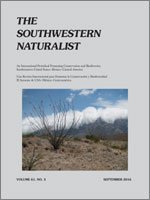Nine-banded armadillos (Dasypus novemcinctus) are nocturnal, semifossorial, insectivorous mammals that historically live in warm climates but have been moving northward over the past 150 y. As armadillos move into more-temperate climates, behavioral adjustments occur in response to decreasing temperatures. Observations in northern latitudes have noted more activity during the daytime in the winter, indicating a shift in circadian rhythm. Such behavioral plasticity may allow individuals to forage when temperatures are optimal for thermoregulation. We recorded armadillo activity for 6 mo using game cameras. We created nocturnal, crepuscular, and diurnal activity indices and then plotted them as a function of time. We compared temperatures of when armadillos were photographed to temperatures when other animals were photographed. Analyses suggest that a seasonal shift in circadian rhythm does occur and that air temperature is an important factor. Although armadillos have previously been reported to have lunar phobia, we saw no evidence of this.
How to translate text using browser tools
1 September 2016
Seasonal circadian rhythm shift and lunar chronobiology of the nine-banded armadillo (Dasypus novemcinctus)
Eric N. Green,
Dana M. Green,
Sean P. Maher,
Lynn W. Robbins
ACCESS THE FULL ARTICLE

The Southwestern Naturalist
Vol. 61 • No. 3
September 2016
Vol. 61 • No. 3
September 2016




